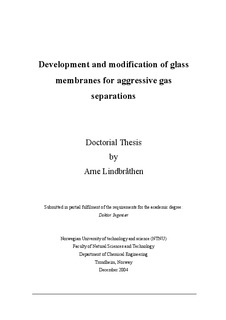| dc.description.abstract | Chlorine as a chemical is widespread in industry and found in a great variety of processes ranging from water purification to plastic production. In this thesis, a magnesium production factory was chosen as an example because it involved both chlorine - air separation and hydrogen –hydrogen chloride separation.
Previously, various types of membrane materials have been tested out for their applicability in the chosen process. The materials previously tested either lacked sufficient membrane performance or sufficient membrane stability. As an attempt to improve both the membrane performance and stability, glass membranes are used in this thesis.
Glass membranes are prepared from a borosilicate glass, via a phase separation followed by an acid leaching route. By choosing the appropriate phase separation temperature and acid to glass ratio, the membrane can be produced with an average pore diameter of 2 nm (or 4 nm).
However, the 2 nm average pore size is still too large to separate gases with separation selectivities beyond the selectivities predicted from Knudsen diffusion theory. If the pores are narrowed, the selectivity may be raised while the flux hopefully is maintained. The narrowing of the pores was done by a silane coupling to the surface OH-groups on the glass. The silane coupling agent is of the dimethylacyl-chlorosilane type, where the length of the acyl chain varies from 1 carbon up to 18 carbons. Glass fibres are also tested in this work, which are produced without phase separation and their average pore size is smaller than the surface-modified glasses.
To be able to compare the performance of the various membranes, permeance measurements are performed and these measurements are evaluated by the separation power (product of the selectivity and the permeability of the fastest permeating compound). Because of the harsh chlorine or hydrogen chloride environment, to which the membranes are exposed in this work, the membrane stability is at least as important s factor as the perm-selectivities. To evaluate this, both short- and longterm aggressive gas exposures are performed using a special designed durability chamber. From the combination of the perm-selectivities and the durability tests, the following conclusions may be drawn (evaluated at 30°C and 1 bar): Firstly, the pure glasses have a relatively poor stability (for chlorine gas) and the perm-selectivity is too low (for both separations in question). Secondly, the C8 and C12 modified glass membranes have a relatively satisfactory perm- selectivity for chlorine separation, but the durability in chlorine is poor. Thirdly, the long-chained C18 modified glass membrane has a relatively satisfactory perm-selectivity but a fair to low chlorine stability. If the C18 membrane is applied in the hydrogen chlorine separation the perm-selectivity is a bit low, but the stability is sufficient. However, this membrane is the best choice for a low temperature HCl selective membrane.
Finally, to improve the chlorine stability, a perfluorinated version of a C1 modification is tried out. This membrane has excellent chlorine stability, and the perm-selectivity is fair. This membrane is the best choice for a chlorine selective membrane.
The stability of the fibres is comparable to that found for the pure glass tubes. However, the permeabilities in the glass fibres are several orders of magnitude lower than for the glass tubes. The pore size in the fibre is so narrow that separation occurs according to a molecular sieving mechanism. The mounting of the fibres into a labsized module is tricky and the permeabilities are at the border of detection, so the results obtained here should only serve as trends. | nb_NO |
